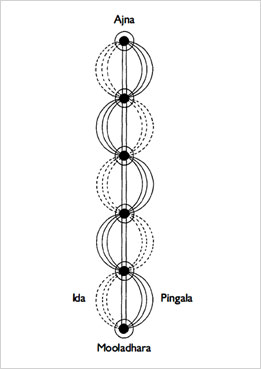The word nadi literally means 'flow' or 'current'. The ancient texts say that there are seventy-two thousand nadis in the psychic body. These are visible as currents of light to a person who has developed psychic vision. Like the chakras, they are not actually part of the physical body, although they correspond with the nerves. Nadis are the subtle channels through which the pranic forces flow. Out of the large number of nadis in the psychic body, ten are major. Of these, three are most significant: ida, pingala and sushumna. The most important of these three is sushumna. All the nadis in the psychic body are subordinate to sushumna.
Ida, pingala and sushumna
Sushumna nadi is the spiritual channel, and to concentrate on it, awareness is taken to the centre of the spinal cord. Sushumna originates from mooladhara chakra and terminates at sahasrara.
Ida nadi flows from the left side of mooladhara in spirals, passing through each chakra in tum, forming a crisscross pathway which terminates at the left side of ajna chakra.
Pingala nadi flows from the right side of mooladhara, mirroring ida, terminating at the right side of ajna.
Ida and pingala represent the two opposite forces flowing within us. Ida is passive, introvert and feminine; it is also known as the chandra or moon nadi. Pingala, on the other hand, is active, extrovert and masculine, and is called the surya or sun nadi.
When ida and pingala nadis are purified and balanced, and the mind is controlled, then sushumna, the most important nadi, begins to flow. Sushumna must be flowing for success in meditation. If pingala flows, the body will be restless; if ida flows, the mind will be overactive. When sushumna flows, kundalini awakens and rises through the chakras.
